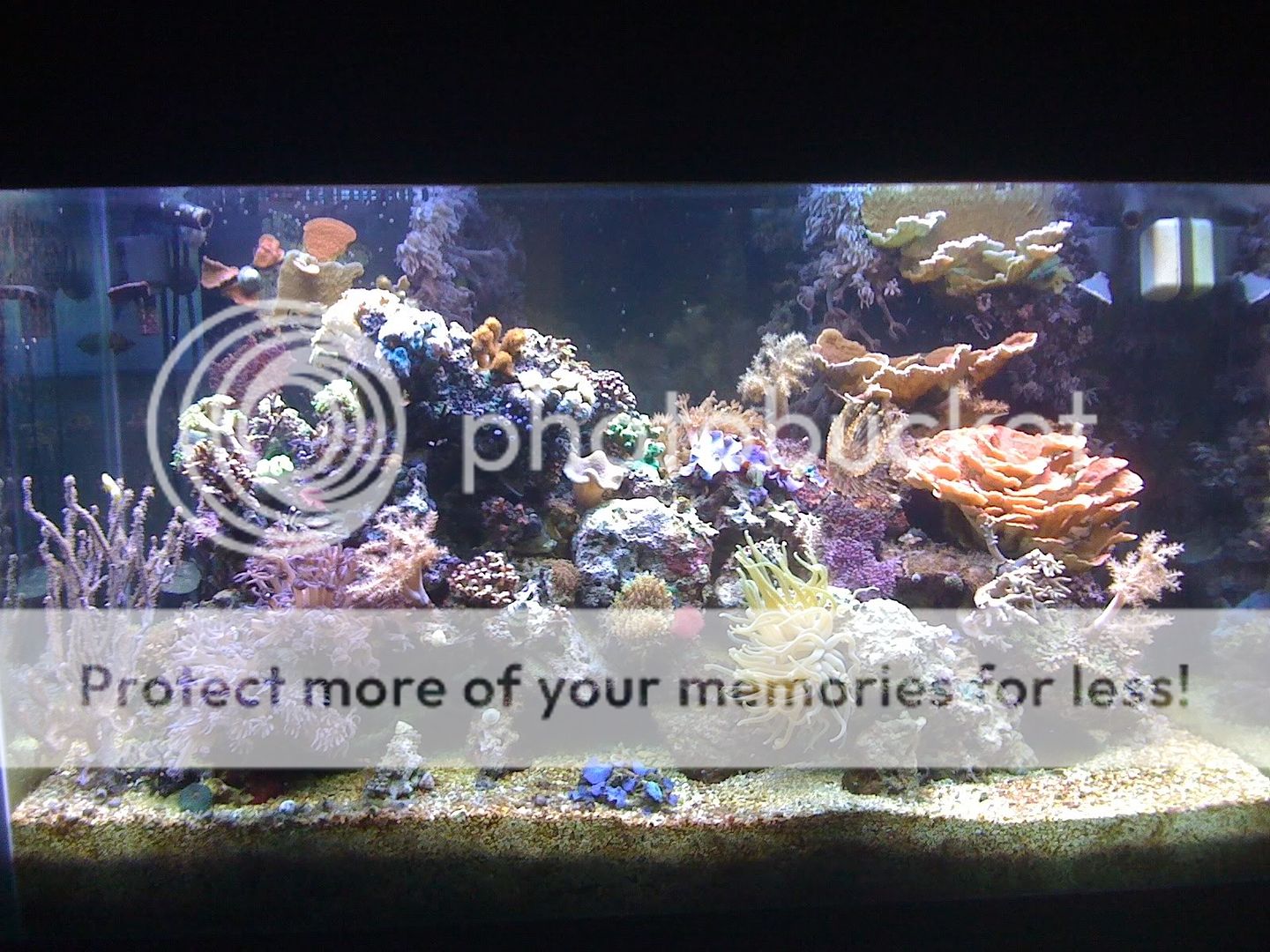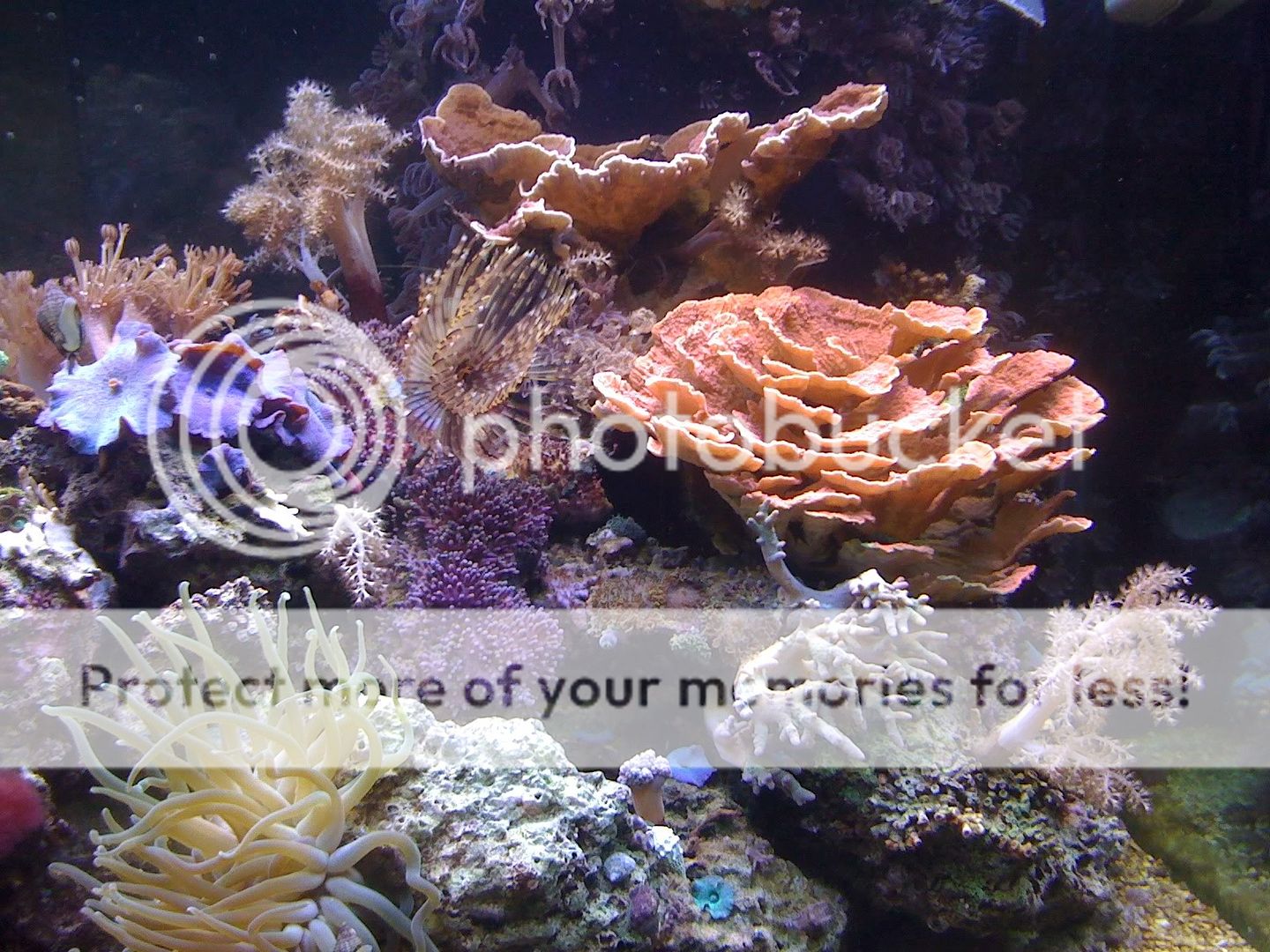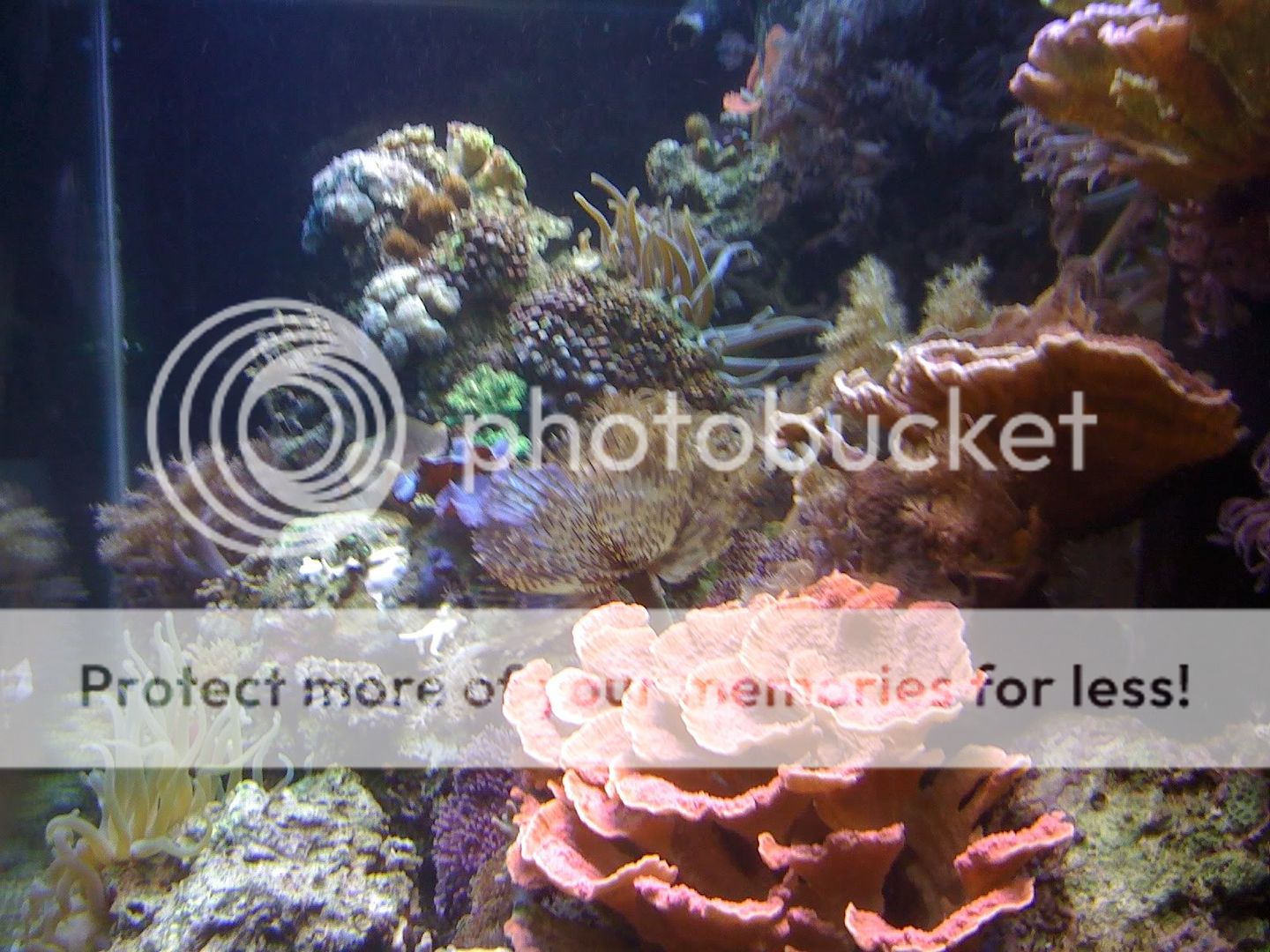freddie40
New member
I am very pleased to announce that the next DARC meeting will be at Orvel's house Directions on June 19th at 1pm. Orvel's house backs up to Golden Gate Canyon Sate Park and the view is spectacular. Orvel's tank is as impressive as the view. As a bonus Orvel asks everyone to bring a frag so that we can have a mini frag swap. I will be there and I hope you too can join us. Here is a description and a few pictures of his tank
This system is based on the approach advocated in the book, Dynamic Aquaria: Building Living Ecosystems, by Walter H. Adey and Karen Loveland, It relies entirely on biological processes and a complex ecosystem of bacteria and benthic fauna for nutrient processing and export.
The delicately-balanced, all-biological filtration was difficult to establish, but it provides a very plankton-rich water column well suited to hard-to-keep inverts, hard and soft corals, while keeping nitrates and phosphates at undetectable levels.
The Reef tank is a 180 gal Oceanic, 48x30x24, which holds approx 250 lbs of Florida Keys aquacultured live rock over an 8” DSB. Lighting is provided by 4 55w T-5s (10,000K, 12,000K and 2x 420nm Actinic, fitted with individual parabolic reflectors) overdriven to 85w by an Icecap 660-009 ballast. The tank is located in the dining room of our all-solar home where it gets a lot of natural light as well. A Little Giant Model 2 main pump delivers approx 1800 GPH of return flow. A set of 4 Maxi-Jet powerheads in the back corners (2x model 400 and 2x model 600) driven by a NaturalWave control timer alternate to create active wave action, while a Hydor Koralia 750, along with another unidentified powerhead, provides continuous circulation in the backreef.
.
A three-chamber 40 gal DIY refugium is concealed in the cabinet. It holds approx 50lbs of Hawaiian coral rubble over a 4” bed of fine sand and miracle mud. A floating mat of macro algae (Chaetomorpha crassa) provides additional biological filtration and nutrient export. It is lit by a CoralLife CF fixture (2x 65w 6,800K) in an alternating cycle with the daylights. An Amiracle protein skimmer and a Three Little Fishes fluidized bed running 500 ml of ROWAphos provide the only mechanical water treatments.
Corals include several Purple, Orange and Brown Plate corals (Montipora capricornis), Endive Hydnophora (Hydnophora grandis), Stylophora and Ocularis SPS hard corals, Blue Candy Cane LPS coral (Caulastrea echinulata), Highlighter Yellow candy cane LPS coral (Acanthastrea lordhowensis), Neon Green Branching Hammer SPS coral (Euphyllia sp.) and soft corals including Sea Pen (Anthelia sp.), Red Sea Pulsing Coral (Xenia elongate), Leather coral (Alcyonium sp.), Neon Green Toadstool Leather (Sarcophyton sp.), Kenya Tree (Capnella sp.), Purple Star Polyps (Pachyclavularia violacea), green, brown and orange zoas (Zoanthus sp.), and two species of Sea Plume gorgonian (Muriceopsis flavida).
Fish include 3 Blue Devil Damsels, 2 Green Chromis (Chromis cyanea), a Yellow Tang (Acanthurus flavescens), a Lawnmower Blenny (Salarias fasciatus), a Royal Grama (Gramma loreto), a Pearly or Yellow-Headed Jawfish (Opistognathus aurifrons)
and a pair of Percula Clownfish (Amphiprion ocellaris).
Inverts include: 2 large Long Tentacle Anemones (Condylactis sp). 2 Brown Brittle Stars (Ophiocoma sp.), 1 Serpent Star (Ophiocoma sp.) a half-dozen Reticulate Brittle Stars (Ophioneresis reticulate), 1 small Spiny Black Urchin (Echinothrix diadema), 2 Mine Urchins (Eucidaris tribuloides, exiled to the fuge), red, blue, purple and green Mushroom Anemones (Actinodiscus sp.), 1 Giant Hawaiian Feather Duster worm (Sabellastarte sp.), 2 Pacific Cleaner Shrimp (Lysmata amboinensis), 7 Peppermint Shrimp (Lysmata wurdemanni), 1 Pistol Shrimp (Alpheus sp.), 1 Coral Banded Shrimp (Stenopus hispidus), abundant Fine Lumpy Sponges, various assorted tube worms, about 30 red- (Calcinus tibicen) and blue-legged (Clibanarius tricolor) hermit crabs and about 20 mixed Mexican Turbo and Artisa (Astrea tecta) snails. And hundreds of tiny Asterina Stars.
The DSB is populated by an undocumented community of cleaner clams, tunneling bristle worms, fire worms, tiny clams, stars and gawd-only-knows what else. I’ve collected and added live sand from the Florida Keys, the Texas Gulf coast, and Atlantic and Pacific beaches in Mexico, California and Hawaii.



This system is based on the approach advocated in the book, Dynamic Aquaria: Building Living Ecosystems, by Walter H. Adey and Karen Loveland, It relies entirely on biological processes and a complex ecosystem of bacteria and benthic fauna for nutrient processing and export.
The delicately-balanced, all-biological filtration was difficult to establish, but it provides a very plankton-rich water column well suited to hard-to-keep inverts, hard and soft corals, while keeping nitrates and phosphates at undetectable levels.
The Reef tank is a 180 gal Oceanic, 48x30x24, which holds approx 250 lbs of Florida Keys aquacultured live rock over an 8” DSB. Lighting is provided by 4 55w T-5s (10,000K, 12,000K and 2x 420nm Actinic, fitted with individual parabolic reflectors) overdriven to 85w by an Icecap 660-009 ballast. The tank is located in the dining room of our all-solar home where it gets a lot of natural light as well. A Little Giant Model 2 main pump delivers approx 1800 GPH of return flow. A set of 4 Maxi-Jet powerheads in the back corners (2x model 400 and 2x model 600) driven by a NaturalWave control timer alternate to create active wave action, while a Hydor Koralia 750, along with another unidentified powerhead, provides continuous circulation in the backreef.
.
A three-chamber 40 gal DIY refugium is concealed in the cabinet. It holds approx 50lbs of Hawaiian coral rubble over a 4” bed of fine sand and miracle mud. A floating mat of macro algae (Chaetomorpha crassa) provides additional biological filtration and nutrient export. It is lit by a CoralLife CF fixture (2x 65w 6,800K) in an alternating cycle with the daylights. An Amiracle protein skimmer and a Three Little Fishes fluidized bed running 500 ml of ROWAphos provide the only mechanical water treatments.
Corals include several Purple, Orange and Brown Plate corals (Montipora capricornis), Endive Hydnophora (Hydnophora grandis), Stylophora and Ocularis SPS hard corals, Blue Candy Cane LPS coral (Caulastrea echinulata), Highlighter Yellow candy cane LPS coral (Acanthastrea lordhowensis), Neon Green Branching Hammer SPS coral (Euphyllia sp.) and soft corals including Sea Pen (Anthelia sp.), Red Sea Pulsing Coral (Xenia elongate), Leather coral (Alcyonium sp.), Neon Green Toadstool Leather (Sarcophyton sp.), Kenya Tree (Capnella sp.), Purple Star Polyps (Pachyclavularia violacea), green, brown and orange zoas (Zoanthus sp.), and two species of Sea Plume gorgonian (Muriceopsis flavida).
Fish include 3 Blue Devil Damsels, 2 Green Chromis (Chromis cyanea), a Yellow Tang (Acanthurus flavescens), a Lawnmower Blenny (Salarias fasciatus), a Royal Grama (Gramma loreto), a Pearly or Yellow-Headed Jawfish (Opistognathus aurifrons)
and a pair of Percula Clownfish (Amphiprion ocellaris).
Inverts include: 2 large Long Tentacle Anemones (Condylactis sp). 2 Brown Brittle Stars (Ophiocoma sp.), 1 Serpent Star (Ophiocoma sp.) a half-dozen Reticulate Brittle Stars (Ophioneresis reticulate), 1 small Spiny Black Urchin (Echinothrix diadema), 2 Mine Urchins (Eucidaris tribuloides, exiled to the fuge), red, blue, purple and green Mushroom Anemones (Actinodiscus sp.), 1 Giant Hawaiian Feather Duster worm (Sabellastarte sp.), 2 Pacific Cleaner Shrimp (Lysmata amboinensis), 7 Peppermint Shrimp (Lysmata wurdemanni), 1 Pistol Shrimp (Alpheus sp.), 1 Coral Banded Shrimp (Stenopus hispidus), abundant Fine Lumpy Sponges, various assorted tube worms, about 30 red- (Calcinus tibicen) and blue-legged (Clibanarius tricolor) hermit crabs and about 20 mixed Mexican Turbo and Artisa (Astrea tecta) snails. And hundreds of tiny Asterina Stars.
The DSB is populated by an undocumented community of cleaner clams, tunneling bristle worms, fire worms, tiny clams, stars and gawd-only-knows what else. I’ve collected and added live sand from the Florida Keys, the Texas Gulf coast, and Atlantic and Pacific beaches in Mexico, California and Hawaii.



Last edited:
